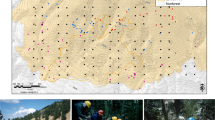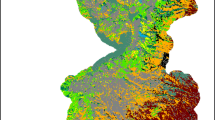Abstract
We used dendroecological techniques to analyze the effects of rainfall and grazing on fire regime and its implications for tree regeneration in subtropical mountains of northwestern Argentina during the 20th century, a period characterized by increasing rainfall and decreasing land-use intensity. We dated fire scars and establishment of Alnus acuminata (the dominant tree species) in six watersheds along a 600 km latitudinal range. We correlated fire frequency with rainfall records and performed Superposed Epoch Analyses to assess the relationship between rainfall and fire events during the century, and in two sub-periods: 1930–1965 (low rainfall, high grazing) and 1966–2001 (high rainfall, low grazing). We performed permutation analyses to assess the association between fire events and tree establishment, and to describe the spatial distribution of fires and forests in relation to hillslope aspect. Rainfall was associated with regional fires at interannual and decadal scales: fire probability increased after growing seasons with above-average rainfall and through the century, in concurrence with rainfall increase. The climatic control of fire was stronger under lower land-use intensity. Tree establishment was temporally associated with fire events, which occurred mainly in north facing slopes, where grassland cover is more extensive and forest colonization more likely. These results suggest that fire is limited by the availability of fine fuels, which is enhanced by high rainfall and reduced grazing; and tree establishment is limited by the competition with grasses. Consequently, increasing rainfall and decreasing grazing favored higher fire frequency, thus promoting forest encroachment during 20th century.






Similar content being viewed by others
References
Aide TM, Grau HR. 2004. Globalization, migration, and Latin American ecosystems. Science 305:1915–16.
Aráoz E. 2009. Dinámica del bosque de alisos en el noroeste de Argentina en respuesta al cambio climático y de uso de la tierra. Tesis doctoral de la Universidad Nacional de Tucumán. Inedit. 124 pp.
Arno SF, Sneck KM. 1977. A method for determining fire history in coniferous forests of the mountain west. U.S. Department of Agriculture Forest Service General Technical Report Int-42.
Bell DA. 1991. Distribución del bosque de aliso de cerro, Alnus acuminata (Betulaceae) en la provincia de Tucumán, Argentina. Boletín de la Sociedad Argentina de Botánica 27:21–30.
Belsky AJ, Blumenthal DM. 1997. Effects of livestock grazing on stand dynamics and soils in upland forests of the interior west. Conserv Biol 11:315–27.
Bolsi A. 1997. La actividad ganadera en el noroeste argentino. In: Bolsi A, Ed. Problemas Agrarios del Noroeste Argentino. San Miguel de Tucumán, Argentina: Universidad Nacional de Tucumán-Junta de Andalucía. p 149–79.
Bond WJ, Keeley JE. 2005. Fire as a global “herbivore”: the ecology and evolution of flammable ecosystems. Trends Ecol Evol 20:387–94.
Bond WJ, Woodward FI, Midgley GF. 2005. The global distribution of ecosystems in a world without fires. New Phytol 165:238–525.
Cabrera AL, Willink A. 1980. Biogeografía de América Latina. Organization of American States, Washington, DC, 122 p.
Carilla J, Grau HR. 2010. 150 years of tree establishment, land use and climate changes in montane grasslands, NW Argentina. Biotropica 42:49–58.
Condit R. 1998. Ecological implications of changes in drought patterns: shifts in forest composition in Panama. Clim Change 39:413–27.
Dale VH, Joyce LA, McNulty S, Neilson RP, Ayres MP, Flannigan MD, Hanson PJ, Irlan LC, Lugo AE, Peterson CJ, Simberloff D, Swanson FJ, Stocks BJ, Wotton BM. 2001. Climate change and forest disturbances. Bioscience 59:723–34.
Davis MA, Grime JP, Thompson K. 2000. Fluctuating resources in plant communities: a general theory of invasibility. J Ecol 88:528–34.
Duncan R. 1989. An evaluation of errors in tree age estimates based on increment cores in Kahikatea (Dacycarpus dacrydioides). N Z Nat Sci 16:31–7.
Elliott GP, Baker WL. 2004. Quaking aspen (Populus tremuloides Michx.) at treeline: a century of change in the San Juan Mountains, Colorado, USA. J Biogeogr 31:733–45.
Foley JA, DeFries R, Asner GP, Barford C, Bonan G, Carpenter SR, Chapin FS, Coe MT, Daily GC, Gibbs HK, Helkowski JH, Howard EA, Holloway T, Kucharik CJ, Monfreda C, Patz JA, Prentice IC, Ramankutty N, Snyder PK. 2005. Global consequences of land use. Science 309:570–4.
Fry DL, Stephens SL. 2006. Influence of humans and climate on the fire history of ponderosa pine-mixed conifer forest in the southeastern Klamath Mountains, California. For Ecol Manag 223:428–38.
Gavin DG, Hallett DJ, Hu FS, Lertzman KP, Prichard SJ, Brown KJ, Lynch JA, Bartlein P, Peterson DL. 2007. Forest fire and climate change in western North America: insights from sediment charcoal records. Front Ecol Environ 5:499–506.
Giusti L, Slanis A, Aceñolaza PG. 1997. Fitosociologia de los bosques de aliso (Alnus acuminata H.B.K. ssp. acuminata) de Tucumán (Argentina). Lilloa 38:93–120.
Grau A. 1985. La expansión del aliso del cerro (Alnus acuminata H.B.K. ssp. acuminata) en el noroeste de Argentina. Lilloa 36:237–47.
Grau HR. 2001. Regional-scale spatial patterns of fire in relation to rainfall gradients. Glob Ecol Biogeogr 10:133–46.
Grau HR. 2005. Dinámica de bosques en el gradiente altitudinal de las Yungas Argentinas. In: Arturi M, Frangi J, Goya J, Eds. Ecología y Manejo de los Bosques Argentinos. La Plata, Argentina: Universidad Nacional de La Plata.
Grau HR, Aide TM. 2008. Globalization and land use transitions in Latin America. Ecol Soc 13:16. http://www.ecologyandsociety.org/vol13/iss2/art16/.
Grau A, Brown AD. 2000. Development threats to biodiversity and opportunities for conservation in the mountain ranges of the upper Bermejo River basin, NW Argentina and SW Bolivia. Ambio 29:445–50.
Grau HR, Veblen TT. 2000. Rainfall variability, fire and vegetation dynamics in neotropical montane ecosystems in north-western Argentina. J Biogeogr 27:1107–21.
Grau HR, Easdale TA, Paolini L. 2003. Subtropical dendroecology-dating disturbances and forest dynamics in northwestern Argentina montane ecosystems. For Ecol Manag 177:131–43.
Grissino-Mayer HD, Swetnam TW. 2000. Century-scale climate forcing of fire regimes in the American southwest. The Holocene 10:213–20.
Guyette RP, Muzika RM, Dey DC. 2002. Dynamics of an anthropogenic fire regime. Ecosystems 5:472–86.
Hessl AE, Baker WL. 1997. Spruce and fir regeneration and climate in the forest-tundra ecotone of Rocky Mountain National Park, Colorado, USA. Arct Alp Res 29:173–83.
Hessl AE, Graumlich LJ. 2002. Interactive effects of human activities, herbivory and fire on quaking aspen (Populus tremuloides) age structures in western Wyoming. J Biogeogr 29:889–902.
Heyerdahl EK, Brubaker LB, Agee JK. 2001. Spatial controls of historical fire regimes: a multiscale example from the interior west, USA. Ecology 82:660–78.
Heyerdahl EK, Morgan P, Riser JP. 2008. Multi-season climate synchronized historical fires in dry forests (1650–1900), Northern Rockies, USA. Ecology 89:705–16.
Izquierdo AE, Grau HR. 2009. Agriculture adjustment, land-use transition and protected areas. J Environ Manag 90:858–65.
Johnson EA, Fryer GI. 1989. Population dynamics in lodgpole pine-engelmann spruce forests. Ecology 70:1335–45.
Kitzberger T, Veblen T, Villalba R. 1997. Climatic influence on fire regime along a rain-forest to xeric woodland gradient in northern Patagonia, Argentina. J Biogeogr 24:35–47.
McCabe GJ, Paleck MA, Betancourt JL. 2004. Pacific and Atlantic Ocean influences on multidecadal drought frequency in the United States. Proc Natl Acad Sci 102:4136–41.
McCarty JP. 2001. Ecological consequences of recent climate change. Conserv Biol 15:320–31.
Minetti JL, Vargas WM. 1997. Trends and jumps in the annual rainfall in South America, south of the 15ºS. Atmosfera 11:205–21.
Morales MS, Villalba R, Grau R, Paolini L. 2004. Rainfall-controlled tree growth in high elevation subtropical treelines. Ecology 85:3080–9.
Nowacki GJ, Abrams MD. 2008. The demise of fire and “mesophication” of forests in the eastern United States. Bioscience 58:123–38.
Prager MH, Hoenig JM. 1989. Superposed epoch analysis: a randomization test of environmental effects on recruitment with application to chub mackerel. Trans Am Fish Soc 118:608–18.
Sankaran M, Ratnam J, Hanan NP. 2004. Tree-grass coexistence in savannas revisited—insights from an examination of assumptions and mechanisms invoked in existing models. Ecol Lett 7:480–90.
Savage M, Swetnam TW. 1990. Early 19th-century fire decline following sheep pasturing in a navajo ponderosa pine forest. Ecology 71:2374–8.
Tian YQ, Davies-Colley RJ, Gong P, Thorrold BW. 2001. Estimating solar radiation on slopes of arbitrary aspect. Agric For Meteorol 109:67–74.
Tinner W, Hubschmid P, Wehrli M, Amman B, Conedera M. 1999. Long term forest fire ecology and dynamics in Southern Switzerland. J Ecol 87:273–89.
Veblen TT, Kitzberger T, Villalba R, Donnegan J. 1999. Fire history in northern patagonia: the roles of humans and climatic variation. Ecol Monogr 69:47–67.
Villalba R, Grau HR, Bonisegna JA, Jacoby GC, Ripalta A. 1998. Tree-ring evidence for long-term precipitation changes in subtropical South America. Int J Climatol 18:1463–78.
Vitousek PM. 1994. Beyond global warming: ecology and global change. Ecology 75:1861–76.
Young KR, León B. 2007. Tree-line changes along the Andes: implications of spatial patterns and dynamics. Philos Trans R Soc B 362:263–72.
Acknowledgments
We thank Julieta Carilla, María José Foguet, Javier Foguet, Florencia Huck, Sofía Marinaro, and Eva Pérez for field assistance; Tomas Easdale, Leonardo Paolini, and three anonymous reviewers for critically commenting on the manuscript. This research was funded by Fondo Nacional para la Ciencia y Técnica (FONCYT), the Consejo Nacional de Investigaciones Científicas y Técnicas (CONICET), and the Research Councyl of the Tucuman National University (CIUNT).
Author information
Authors and Affiliations
Corresponding author
Additional information
Author contributions: Ezequiel Aráoz performed research, analyzed data, contributed new methods, and wrote the paper. H. Ricardo Grau conceived study, contributed new models, and wrote the paper.
Rights and permissions
About this article
Cite this article
Aráoz, E., Grau, H.R. Fire-Mediated Forest Encroachment in Response to Climatic and Land-Use Change in Subtropical Andean Treelines. Ecosystems 13, 992–1005 (2010). https://doi.org/10.1007/s10021-010-9369-7
Received:
Accepted:
Published:
Issue Date:
DOI: https://doi.org/10.1007/s10021-010-9369-7




